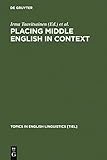Placing Middle English in Context / ed. by Irma Taavitsainen, Terttu Nevalainen, Päivi Pahta, Matti Rissanen.
Material type: TextSeries: Topics in English Linguistics [TiEL] ; 35Publisher: Berlin ; Boston : De Gruyter Mouton, [2011]Copyright date: ©2000Edition: Reprint 2011Description: 1 online resource (518 p.)Content type:
TextSeries: Topics in English Linguistics [TiEL] ; 35Publisher: Berlin ; Boston : De Gruyter Mouton, [2011]Copyright date: ©2000Edition: Reprint 2011Description: 1 online resource (518 p.)Content type: - 9783110167801
- 9783110869514
- 427/.02 22
- PE524 .P58 2000eb
- online - DeGruyter
- Issued also in print.
| Item type | Current library | Call number | URL | Status | Notes | Barcode | |
|---|---|---|---|---|---|---|---|
 eBook
eBook
|
Biblioteca "Angelicum" Pont. Univ. S.Tommaso d'Aquino Nuvola online | online - DeGruyter (Browse shelf(Opens below)) | Online access | Not for loan (Accesso limitato) | Accesso per gli utenti autorizzati / Access for authorized users | (dgr)9783110869514 |
I-IV -- Preface -- Contents -- Introduction -- Chronological and social context -- Language periodization and the concept “middle” -- Language and society in twelfth-century England -- Syntactic constraints on code-switching in medieval texts -- Dialect, normalization and corpus-linguistic methodology -- Introduction -- Never the twain shall meet. Early Middle English - the East-West divide -- Standard language in Early Middle English? -- Changing spaces: Linguistic relationships and the dialect continuum -- Normalizing the word forms in The Ayenbite of Inwyt -- Chaucer's spelling and the manuscripts of the Canterbury Tales -- WHICH and THE WHICH in Late Middle English: Free variants? -- Lexical semantics -- Introduction -- Robbares and reuares þat ryche men despoilen: Some competing forms -- Here comes the judge: A small contribution to the study of French input into the vocabulary of the law in Middle English -- Naming and avoiding naming objects of terror: A case study -- An application of the Natural Semantic Metalanguage to diachronic semantics -- Patterns of semantic change in abstract nouns: The case of wit -- The spatial and temporal meanings of before in Middle English -- The adjective weary in Middle English structures: A syntactic-semantic study -- Utterance and discourse meaning -- Introduction -- Slanders, slurs and insults on the road to Canterbury: Forms of verbal aggression in Chaucer's Canterbury Tales -- Hir not lettyrd: The use of interjections, pragmatic markers and whan-clauses in The Book of Margery Kempe -- Whoso thorgh presumpcion ... mysdeme hyt: Chaucer's poetic adaptation of the medieval “book curse” -- Sounds, prosody and metre -- Introduction -- Middle English prosodic innovations and their testability in verse -- Old English (non)-palatalised */k/: Competing forces of change at work in the “seek”-verbs -- Some remarks on the nonprimary contexts for Homorganic Lengthening -- On the phonetic and phonological interpretation of the reflexes of the Old English diphthongs in the Ayenbite of Inwyt -- Author index -- Subject index
restricted access online access with authorization star
http://purl.org/coar/access_right/c_16ec
Issued also in print.
Mode of access: Internet via World Wide Web.
In English.
Description based on online resource; title from PDF title page (publisher's Web site, viewed 28. Feb 2023)


